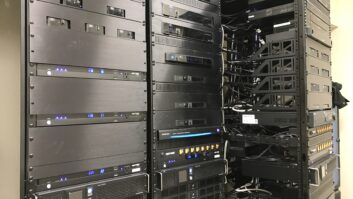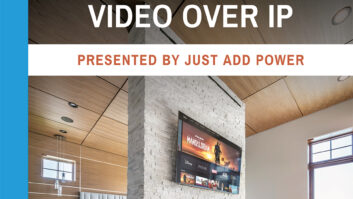This Integration Guide was sponsored by Access Networks, Control4, Luxul, and Peerless-AV as a supplement to Residential Systems, May 2017
The scenario is familiar: you and your family have gathered in the family room, popcorn freshly popped and lights suitable dimmed, to watch an agreed-upon film on one of the popular streaming services. Just as the movie is getting good, the screen is filled with a gray spinning circle. Your slow internet connection has interrupted the movie so that it can buffer the content.

Thinkstock/scyther5
As we move fully into IP-based entertainment and more internet-connected devices vie for a place on overtaxed home networks, it has never been more critical for consumers and home technology professionals to get up to speed. The interest and requirement for robust networks, often seen in more commercial-grade networking projects, have never been higher. This demand has seen manufacturers and technology developers coming up with a range of products ready to address current and future needs of home networking, especially as gigabit internet becomes more popular in the home. But how are home tech pros keeping up with customer needs?
Staying in the Game
Long warned that expertise in IP networking was going to be a necessary skillset if they were going to keep up with the shift toward more IP-based connected home systems, residential integration firms have wasted no time in getting their firms up to speed. Solidifying partnerships that bring with them access to training as well as a set of products, many home tech pros even have crafted their own IP and IT departments specifically to address the shift in home tech culture.

Henry Clifford, LiveWire
“Our DNA is IT,” said Henry Clifford, president of LiveWire. “We’ve watched the home technology world wend its way from IR and serial to IP control with satisfaction. As we’ve grown, we’ve made our first-year training program include courses like Control4’s basic networking fundamentals course and other agnostic trainings so our people understand the underlying concepts behind IP networking, and most importantly, the inherent pitfalls to avoid. Our training features a learning management system (LMS) as well as mandatory field training time with accompanying evaluations.”
LiveWire’s LMS, created by the firm after what they saw as a shortage of resources in the CEDIA world, has been shared with fellow integrators and channel partners in effort to help the industry improve, Clifford noted.

Similarly, Audio Video Systems in Plainview, NY, trains its IT team with help from Pakedge, which also gets the entire staff familiar with Pakedge’s product line. “For AV integrators, the network has become the backbone to our systems. To stay ahead of the curve, AV integrators should be installing fully managed networks with remote monitoring and remote power management,” said Edward Pepitone, director of IT at Audio Video Systems. “This allows remote forensics down to the switch port, as well as remote power cycling devices throughout the residence, without ever rolling a truck. Remote monitoring allows the integrator to know immediately when a client’s devices (or even entire sites) are down. Being proactive instead of reactive ensures a better customer experience.”

The ghostly image of a networked AV cabinet from a Spire Integrated Systems project in Michigan
Spire Integrated Systems Inc., in Troy, MI, requires all new employees to take an online IP networking course in addition to its two-prong approach to IP networking training, which requires outsourcing larger, more complex projects to their partner, WhyReboot, a company that creates customized plug-and-play network systems and provides “white-glove” service and configuration changes for up to a year after installation.

Navot Shoresh, Spire Integrated Systems Inc.
“This allowed us to stay competitive on medium-size projects and have the full support and expertise needed for our larger estate projects,” said Navot Shoresh, the firm’s president. “This approach allowed us to stay current on setup of networks and created a new source for training and knowledge with Bjorn Jensen and his team at WhyReboot.”

Vendor-led training is also the norm at Dennis Sage Home Entertainment in Phoenix, AZ, where that education is bolstered by the constant viewing of webinars to enhance staff (both technical and sales) product knowledge. “We have tried to focus on one trade partner so that when designing and setting up systems they can easily be repeatable,” said Marty Hayse, DSHE’s director of purchasing and sales. “Our leading trade partner is Luxul, and we have had tremendous support both locally, and from Luxul directly, in ensuring that we are putting our best foot forward. This focus has helped our business a great deal, and it has showed our clients that we can design and implement a very strong network for them to enjoy. It has also enabled us to sell better products.”
System Implementation and Maintenance
Gigabit internet promises a superfast connection speed, making it easier for commercial and residential professionals to integrate reliable networking systems that can handle several electronic devices, appliances, and control system functions with relative ease. But that’s only part of the equation.
“When designing the network, it is important to look at not only your scope, but the scope of the entire project,” Pepitone noted. “How many buildings/structures? What kind of integration? Modern security systems, camera systems, phone systems, and HVAC systems are all controlled via IP. If you are installing the network, all fingers will point to you when something isn’t working. It is important to set up VLANs and segment traffic. This will make it easier to create IP schemes and ranges for the different vendors. VLANs also make it easy to prioritize network traffic to ensure the network is performing optimally.”
Pepitone’s team at Audio Video Systems recently had a largescale project in the Hamptons, NY, where the VLAN setup was critical to a positive outcome. Faced with a residential complex with four structures connected via fiber and a unified, fully managed network running throughout, Pepitone’s team’s greatest challenge were the guests’ suites. Each featured a Sonos and an iPad control, and the client wanted each room to work independently of the others and from the rest of the house.
“Each room was set up to its own VLAN, right down to the data jacks,” Pepitone said of the solution. “In the wireless LAN controller, separate wireless networks were set up for each room. This allowed us to isolate each guest bedroom so that each iPad and Sonos would work independently of each other.”
The Dennis Sage Home Entertainment team often walks through a large-scale project noting challenges that will indicate which products will offer the best solutions. Among these is Luxul’s XWS2510 controller access point solution, which allows seamless roaming between multiple access points, simple configuration of 16 Luxul access points, and offers a secure guest network. The solution, Hayse said, allows his team make their systems repeatable and has given them greater confidence in specifying jobs where they can best achieve the client brief, as they did in a past project where they were able to map a home’s low-signal spots and easily design a controller-based system boosted by additional access points to ensure proper signal hand-off to wireless devices.
“We still strongly believe in having wire in the house and fiber where applicable for those critical home office applications,” Hayse said. “As a part of our specifying a network, especially in new construction, we still highly recommend copper and we use the Audioquest CAT600. This really gives the best of both worlds and the clients love the flexibility of the combination of wireless and hard-wired.”
LiveWire works with Access Networks on high-end projects, utilizing Ruckus wireless gear and Cisco switches, while in middle-tier jobs the team uses a combination of Ubiquiti (provider of wireless networking products) and eero (a home-based Wi-Fi network system powered by the company’s TrueMesh technology) gear according to application needs. A project that the LiveWire team inherited from another integrator several years ago consisted of technology silos where the system routinely fell offline. A $40,000 network solution was finally green lit, after months of trying to convince them that the network was the real problem.
“The biggest issue for us is the ability to remotely manage the systems we install, and that all begins with the network design,” Clifford said. “We continue to evaluate and implement a wide variety of network manufacturers, with simplicity and stability driving our specification decision process. We’ve been using managed networks to segment traffic, mesh networks to easily eliminate dead spots without pulling new wire, and remote managed services appliances to monitor the health and performance of our networks.”
Having moved to Cat-6 and fiber a few years ago, Spire Integrated Systems utilizes its relationship with WhyReboot and HTSA to learn about and share best practices in home networking, including security of the system. For that, Spire employs enterprise-grade SonicWall routers even on smaller scale projects. The team recently got what it called an “amazing lesson” in large network deployment when a project on a large estate consisting of multiple buildings and long-distance camera locations required fast and reliable deployment of Wi-Fi with a fiber backbone throughout the building’s indoor and outdoor spaces. With design from WhyReboot and its relationship with Ruckus, a field engineer came out to the site to work with the team and locate where the WAPs should go using a Wi-Fi heat map. Three separate SonicWall routers were deployed with constant VPN to create one large network across three buildings.
“We do not open ports unless a client signs a release form explaining the risk of the open port practice,” Shoresh said of his team’s focus on network security. “We used to set up the SonicWall routers ourselves but moved the setup to WhyReboot. We found the process to be much faster and the setup more complete.”
Staying Ahead of the Curve
As emerging experts in providing home networking solutions, integrators have had to educate themselves on how they can best serve a client base that often turns to them when any aspect of a custom home system goes wrong.
“I think that the biggest thing that we have found is the old adage the you get what you pay for,” Hayse said. “We will not install user-owned network equipment, as we cannot guarantee performance. We say—especially with the bandwidth challenges of today and into the future—you need better equipment. We want to ensure to the user that when we leave the house, the network will perform in the manner that they expect. So, selling and designing the system from the ground up allows us to make that claim, and if they don’t want to make that investment, then we are not the right company for them to be working with.”
Partnerships with networking experts, including vendors and IP networking services, is also an across-the-board recommendation, as is the cry to never cut corners or experiment on your clients.
“Just because you sell and install ‘enterprise’ equipment doesn’t automatically mean the network will perform better,” Pepitone said. “You need to be properly trained on configuring, installing, optimizing, and troubleshooting that equipment. One suggestion I can make is: don’t use your clients and guinea pigs. Set up a test rack at the office. Figure things out there, not in the field. Firmware upgrades are very important to network equipment, but sometimes they can fix one thing and break something else. It is better to break the office test rack than a client’s house before that inevitable big party.”
Llanor Alleyne is a contributing editor to Residential Systems.
NETWORKING PRODUCTS VIEWPOINT
IoT has already begun to redefine approaches to residential systems integration. How are your networking products, in their functionality, ensuring a robust and high-functioning system?
BY CLARK ROUNDY, VP OF MARKETING AND PRODUCT MANAGEMENT, LUXUL
IoT devices and systems are only as good as the network to which they are connected. The network is quite literally the foundation on which modern entertainment, security, control, and automation systems are built. Luxul has recently announced the Epic series of routers that are purpose-built to help integrators deliver a more robust network that translates directly into a better customer experience, regardless of the size or scale of the network. The Epic series is far more than a traditional router—it is designed as a platform on which third-party software applications like remote management tools from Domotz and enhanced content filtering from Router Limits can reside. Epic routers offer Luxul integrators a significant advantage in terms of how they deliver support and services to their customers, along with a perfect platform upon which to build recurring revenue.

NETWORKING PRODUCTS
What products have Luxul been developing to address issues encountered in complex, large-scale residential networking systems?
Luxul’s new Epic line of commercial-grade routers—delivered through Luxul and third-party applications running on the Epic platform—optimize the user experience in smart homes, workplaces, retail establishments, and more. The first of these offerings is enhanced content filtering from Router Limits, with remote management tools from Domotz to follow in Q2. Additional applications, including Ihiji’s remote network management tools and Luxul’s award-winning Roam-Assist wireless controller technology are on the way. Epic routers are available in two basic configurations: The Epic 4 Series and the Epic 5 Series. The Epic 4 Series is designed to offer a solid 600-plus Mbps WAN to LAN performance experience, while the Epic 5 is designed for higher-end installations relying on a fiber connection, offering a full gigabit per second. Epic 4 routers are available now on authorized distributor shelves while the Epic 5 is expected to ship in this month.







